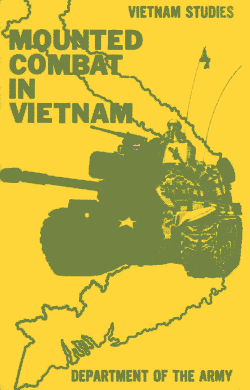| Chapter |
Page
|
| I.
INTRODUCTION |
3 |
| Influence
of French Use of Armor |
3 |
| US
Armored Forces After 1945 |
6 |
| Vietnam
as a Field for Armor |
9 |
| The
Enemy in Vietnam |
10 |
| II.
ARMOR IN THE SOUTH VIETNAMESE ARMY |
17 |
| US
Advisers |
19 |
| M113's
in the Mekong Delta |
21 |
| Reorganization
and Retrenchment |
24 |
| Expansion
of Armor in the South Vietnamese Army |
30 |
| Cuu
Long 15 |
31 |
| Time
for Corrective Analysis |
33 |
| Improvements
in Equipment |
37 |
| Enemy
Reaction to Armored Vehicles |
45 |
| "Coup
Troops" |
48 |
| III.
GROWTH OF US ARMORED FORCES IN VIETNAM |
50 |
| The
Marines Land |
52 |
| Decision
Making |
54 |
| Scouts
Out |
58 |
| Ap
Bau Bang |
60 |
| Deployments
and Employments |
63 |
| Task
Force Spur |
65 |
| Battles
on the Minh Thanh Road |
66 |
| The
Blackhorse Regiment |
72 |
| Mine
and Countermine |
79 |
| IV.
COMBINED ARMS OPERATIONS |
84 |
| The
MACOV Study |
84 |
| Cedar
Falls-Junction City |
91 |
| Mechanized
Operations in the Mekong Delta |
103 |
| Route
Security and Convoy Escort |
106 |
| Air
Cavalry Operations |
111 |
| Other
Free World Armor |
112 |
| V.
THREE ENEMY OFFENSIVES |
114 |
| Enemy
Buildup |
114 |
| First
Offensive: Tet 1968 |
116 |
| Battle
of Tan Son Nhut |
118 |
| Battle
of Long Binh and Bien Hoa Area |
123 |
| Battles
in Vinh Long Province |
127 |
| Second
Offensive |
129 |
| Third
Offensive |
131 |
| Aftermath |
136 |
| VI.
THE FIGHT FOR THE BORDERS |
138 |
| Changing
Strategy |
138 |
| Armored
Forces Along the Demilitarized Zone |
139 |
| The
Sheridan |
142 |
| "Pile-on" |
145 |
| Rome
Plows |
147 |
| Tank
Versus Tank |
149 |
| Invading
the Enemy's Sanctuaries |
153 |
| Securing
the Borders |
156 |
| Pacification
Efforts |
161 |
| Vietnamese
Forces Take Over the War |
164 |
| VII.
ACROSS THE BORDER: SANCTUARIES IN CAMBODIA AND LAOS |
166 |
| Early
Operations Into Cambodia |
167 |
| The
Main Attack Into Cambodia |
168 |
| South
Vietnamese Army Attacks Continue |
176 |
| Secondary
Attacks Across the Border |
178 |
| Cambodia
in Perspective |
179 |
| Maintenance
and Supply |
181 |
| Lam
Son 719 |
186 |
| The
South Vietnamese Army Attack |
190 |
| Air
Cavalry and Tanks |
193 |
| The
Withdrawal |
194 |
| Cuu
Long 44-02 |
197 |
| VIII.
THE ENEMY SPRING OFFENSIVE OF 1972 |
199 |
| Point
and Counterpoint |
200 |
| The
20th Tank Regiment |
203 |
| Attack
Across the Demilitarized Zone |
205 |
| The
Rock of Dong Ha |
206 |
| The
Enemy Attack in Military Region 2 |
212 |
| The
Aftermath |
217 |
| IX.
REFLECTIONS |
220 |
| APPENDIX A
VIETNAM UNIT COMMANDERS |
227 |
| APPENDIX B
ARMOR RECIPIENTS OF THE MEDAL OF HONOR |
238 |
| GLOSSARY |
239 |

